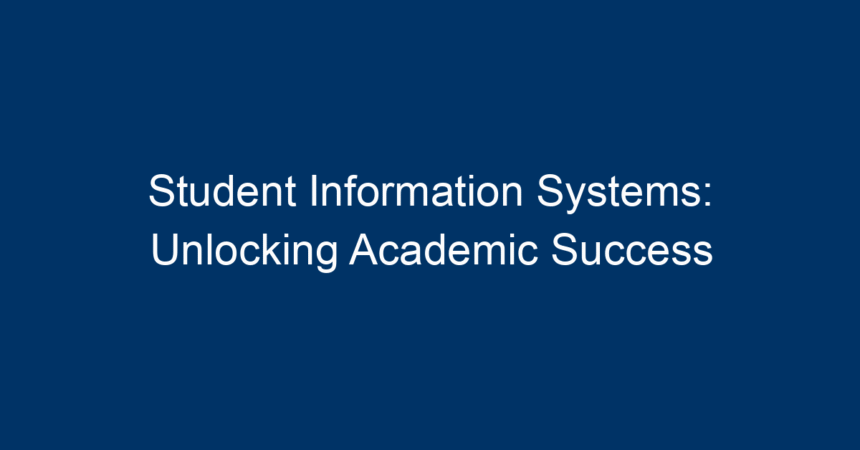In today’s rapidly evolving educational landscape, achieving academic success hinges on the effective management of student data. Enter Student Information Systems (SIS)—the backbone of education technology. These systems are designed to streamline data management, enhance communication, and improve educational outcomes, making them invaluable tools for institutions. In this article, we’ll explore the significant role of student information systems, their features, benefits, and how they can be leveraged to unlock academic potential.
What are Student Information Systems?
Student Information Systems (SIS) are comprehensive software applications that manage a broad spectrum of academic data, ranging from enrollment and grading to attendance tracking and reporting. These systems allow educational institutions to consolidate student information into a single platform, making it easier for administrators, teachers, and students to access and manage relevant data in real-time.
Key Components of SIS:
- Enrollment and Registration: Automates the enrollment process, saving time and reducing administrative burdens.
- Attendance Tracking: Provides real-time insights into student attendance, enabling timely interventions when necessary.
- Grading and Assessment: Facilitates efficient grading processes, allowing educators to manage assignments and report cards seamlessly.
- Reporting: Generates detailed reports on student performance, enrollment trends, and institutional effectiveness.
The Importance of Student Information Systems in Education
With increasing demands for transparency and accountability in education, student information systems have become essential tools for any academic institution. Here are some key ways SIS contributes to academic success:
1. Enhanced Data Management
The sheer volume of data generated in educational settings can be overwhelming. A robust student information system helps institutions manage this data efficiently. With a centralized system, educators can store, access, and analyze student information effortlessly.
For instance, schools can evaluate trends in attendance, identify at-risk students, and tailor interventions accordingly. This data-driven approach not only saves time but also facilitates informed decision-making.
2. Improved Communication
Effective communication is crucial for fostering a supportive academic environment. Student information systems enhance communication between various stakeholders—students, parents, teachers, and administrators.
SIS often includes communication tools, such as announcement features, messaging systems, and portals, where parents can monitor their child’s progress. This transparency fosters a supportive community and encourages parental involvement in education, further motivating students to achieve academic success.
3. Personalized Learning Experiences
In today’s diverse educational landscape, one-size-fits-all approaches often fall short. Student information systems enable personalized learning by providing insights into individual student performance and learning preferences.
By analyzing data, educators can identify students’ strengths and weaknesses, allowing them to tailor curriculum and instructional methods that cater to each student’s unique needs. This personalized approach enhances engagement and promotes better academic outcomes.
4. Simplified Administrative Tasks
Administrative tasks can often detract from educational priorities. Student information systems simplify various administrative processes, such as attendance tracking, grading, and report generation, freeing up valuable time for educators.
Moreover, automating routine administrative functions reduces the likelihood of errors, ensuring that student data is accurate and up-to-date. Educators can then focus their energies on teaching and mentoring students, which can substantially impact student success.
5. Data Security and Compliance
In today’s digital age, data security is paramount, especially when it comes to sensitive student information. Most student information systems are designed with robust security features to protect data from breaches and unauthorized access.
Additionally, SIS helps educational institutions maintain compliance with regulatory standards, such as FERPA (Family Educational Rights and Privacy Act) in the U.S., ensuring that student information is managed responsibly.
Choosing the Right Student Information System
As educational institutions recognize the value of student information systems, the next challenge is selecting the right system that meets their unique needs. Here are some factors to consider when choosing an SIS:
1. Scalability
As your institution grows, so too will your data management needs. Opt for a student information system that can scale easily, accommodating a growing student population without compromising performance.
2. User-Friendly Interface
A complex system can hinder effective use. Choose an SIS with an intuitive user interface that simplifies navigation and minimizes the learning curve for both educators and students.
3. Customization Options
Every institution has unique needs. Look for a system that offers customization features, allowing you to tailor the platform according to your specific processes and workflows.
4. Integration Capabilities
A student information system should integrate seamlessly with other educational technologies your institution uses, such as Learning Management Systems (LMS), financial software, and communication tools. This interconnectedness enhances data flow and efficiency.
5. Support and Training
Implementing a new SIS can be daunting. Ensure that the vendor offers adequate training and support to help your staff navigate the system effectively, minimizing disruptions during the transition.
Best Practices for Implementing Student Information Systems
Implementing a student information system can be a game-changer, but successful integration requires careful planning. Here are some best practices to follow:
1. Stakeholder Involvement
Engage all stakeholders in the planning process, including administrators, educators, IT staff, and even students. Their input will provide valuable insights into the features and functionalities that are most beneficial.
2. Comprehensive Training
Provide extensive training sessions for all users, which will boost confidence and ease the adoption of the new system. Consider creating multimedia training materials that are easily accessible.
3. Data Migration Strategy
When transitioning from an old system to a new SIS, establish a well-planned data migration strategy. Ensure that all existing student information is accurately transferred to the new system to avoid data loss.
4. Continuous Evaluation
Post-implementation, regularly evaluate the system’s effectiveness. Gather feedback from users to make necessary adjustments and ensure that the SIS continues to meet institutional needs.
Conclusion: Unlocking Academic Success with Student Information Systems
In an era where data-driven decision-making is paramount, student information systems stand out as powerful tools that significantly enhance the educational landscape. By streamlining administrative processes, improving communication, and providing personalized learning experiences, SIS unlocks academic success for both students and institutions alike.
Adopting a student information system is not just a technological upgrade; it’s a strategic move toward fostering a more efficient, transparent, and supportive learning environment. For educational institutions striving for excellence, investing in the right SIS is a crucial step toward achieving academic success.
As you consider implementing a student information system, bear in mind the importance of stakeholder involvement, training, and continuous evaluation. By following these actionable insights, you’ll be well on your way to unlocking the full potential of your students and your institution. Embrace the future of education with a robust student information system today!




